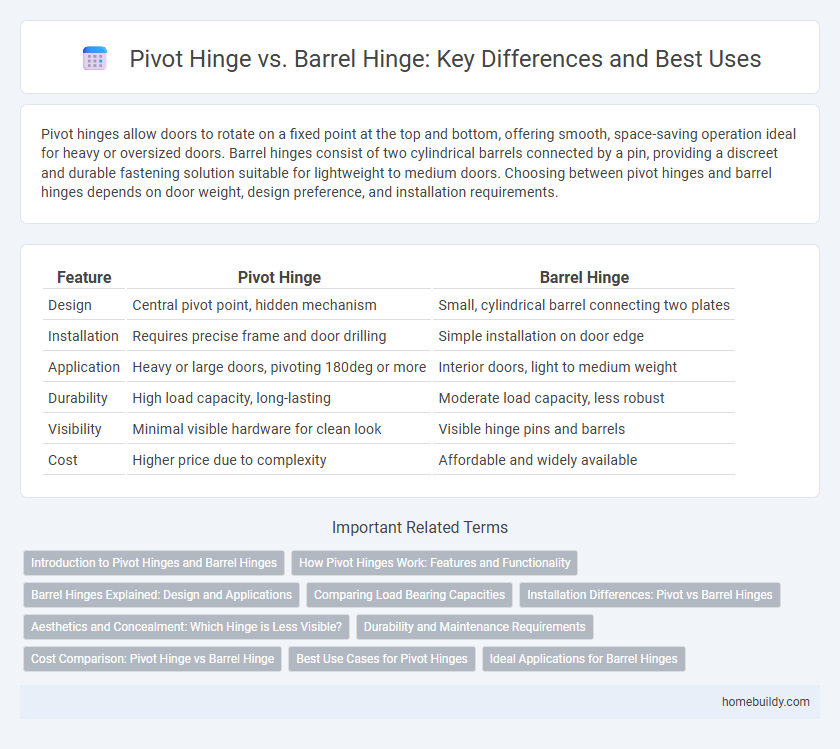Pivot hinges allow doors to rotate on a fixed point at the top and bottom, offering smooth, space-saving operation ideal for heavy or oversized doors. Barrel hinges consist of two cylindrical barrels connected by a pin, providing a discreet and durable fastening solution suitable for lightweight to medium doors. Choosing between pivot hinges and barrel hinges depends on door weight, design preference, and installation requirements.
Table of Comparison
| Feature | Pivot Hinge | Barrel Hinge |
|---|---|---|
| Design | Central pivot point, hidden mechanism | Small, cylindrical barrel connecting two plates |
| Installation | Requires precise frame and door drilling | Simple installation on door edge |
| Application | Heavy or large doors, pivoting 180deg or more | Interior doors, light to medium weight |
| Durability | High load capacity, long-lasting | Moderate load capacity, less robust |
| Visibility | Minimal visible hardware for clean look | Visible hinge pins and barrels |
| Cost | Higher price due to complexity | Affordable and widely available |
Introduction to Pivot Hinges and Barrel Hinges
Pivot hinges provide a unique door mounting solution by allowing the door to rotate around a pivot point at the top and bottom, ideal for heavy or high-traffic doors. Barrel hinges consist of two interlocking metal barrels with a central pin, enabling smooth rotation and easy installation, commonly used for cabinet doors and lightweight applications. Both hinge types optimize door movement and durability, with pivot hinges suited for architectural designs and barrel hinges preferred for compact, concealed installations.
How Pivot Hinges Work: Features and Functionality
Pivot hinges operate by rotating around a fixed pin located at the top and bottom edges of a door, enabling smooth and stable movement without the need for a traditional hinge on the side. These hinges support heavy doors and allow for a clean, modern aesthetic by being concealed within the door and frame. The functionality of pivot hinges provides greater weight distribution and durability compared to barrel hinges, which are typically simpler and mounted entirely on the door edge.
Barrel Hinges Explained: Design and Applications
Barrel hinges feature a cylindrical design that allows for smooth and quiet door operation, making them ideal for lightweight doors and cabinets. Their compact structure fits neatly inside the door and frame, minimizing visual impact while ensuring durability and ease of installation. Commonly used in residential cabinetry and furniture, barrel hinges provide a reliable solution for applications requiring discreet yet sturdy pivot mechanisms.
Comparing Load Bearing Capacities
Pivot hinges support doors by bearing weight at the top and bottom, enabling them to hold heavy and oversized doors effectively. Barrel hinges, typically cylindrical and installed within the door and frame, are better suited for lighter to medium loads but may not withstand the weight of large, heavy doors. Choosing between pivot and barrel hinges depends on the door's weight, size, and frequency of use to ensure optimal load distribution and durability.
Installation Differences: Pivot vs Barrel Hinges
Pivot hinges require installation at the top and bottom of the door frame, allowing the door to rotate around a fixed point and often necessitating precision alignment within the door jamb. Barrel hinges are cylindrical and installed by drilling matching holes into both the door and the frame, enabling the hinge to be recessed for a flush and concealed fit. The installation of barrel hinges is typically simpler and less invasive, while pivot hinges demand more structural modifications for proper alignment and smooth operation.
Aesthetics and Concealment: Which Hinge is Less Visible?
Pivot hinges offer superior concealment as they are installed within the door and frame, making them less visible and ideal for minimalist or modern aesthetics. Barrel hinges protrude slightly from the door surface, resulting in a more noticeable appearance that may complement traditional or rustic design styles. Choosing pivot hinges enhances a sleek, seamless look by minimizing hinge exposure in door installations.
Durability and Maintenance Requirements
Pivot hinges offer exceptional durability due to their ability to support heavier doors with minimal wear, making them ideal for high-traffic areas. Barrel hinges, while simpler in design, require regular lubrication and inspection to prevent rust and ensure smooth operation over time. Choosing between the two depends on balancing the need for long-lasting performance with periodic maintenance efforts.
Cost Comparison: Pivot Hinge vs Barrel Hinge
Pivot hinges typically cost more upfront due to their complex installation requirements and durable construction designed for heavy doors. Barrel hinges offer a more budget-friendly option, especially suitable for lightweight doors and smaller projects, with simpler mounting processes reducing labor expenses. Choosing between pivot and barrel hinges often depends on balancing initial cost against long-term durability and door type.
Best Use Cases for Pivot Hinges
Pivot hinges are ideal for heavy or high-traffic doors due to their robust support, allowing seamless rotation around a central point without stressing the door frame. Commonly used in commercial buildings, pivot hinges facilitate large, swinging doors that require smooth operation and durability. They are also preferred for architecturally unique designs where concealed hardware and minimal visibility are important.
Ideal Applications for Barrel Hinges
Barrel hinges are ideal for applications requiring a concealed, compact mechanism with smooth, quiet operation, such as cabinet doors, small boxes, and lightweight furniture. Their cylindrical design allows them to be recessed into the door and frame, providing a clean aesthetic without exposed hardware. Barrel hinges excel in projects where durability and minimal maintenance are essential, typically in residential and light commercial environments.
pivot hinge vs barrel hinge Infographic

 homebuildy.com
homebuildy.com